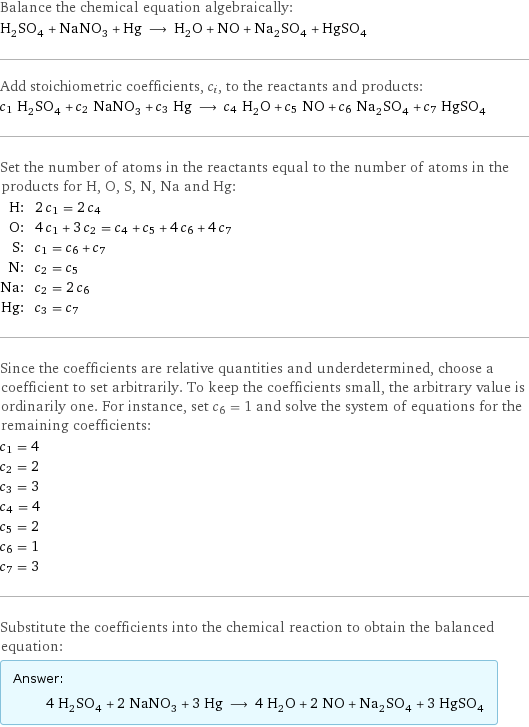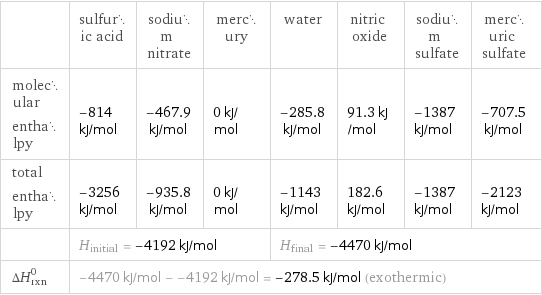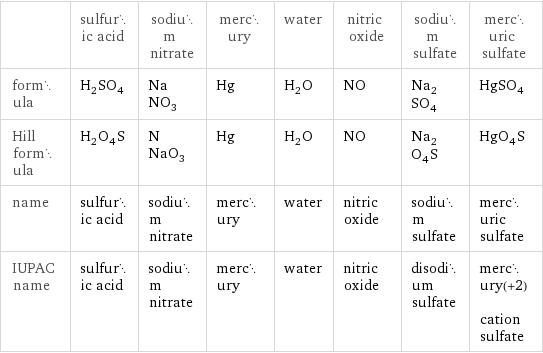Input interpretation

H_2SO_4 sulfuric acid + NaNO_3 sodium nitrate + Hg mercury ⟶ H_2O water + NO nitric oxide + Na_2SO_4 sodium sulfate + HgSO_4 mercuric sulfate
Balanced equation

Balance the chemical equation algebraically: H_2SO_4 + NaNO_3 + Hg ⟶ H_2O + NO + Na_2SO_4 + HgSO_4 Add stoichiometric coefficients, c_i, to the reactants and products: c_1 H_2SO_4 + c_2 NaNO_3 + c_3 Hg ⟶ c_4 H_2O + c_5 NO + c_6 Na_2SO_4 + c_7 HgSO_4 Set the number of atoms in the reactants equal to the number of atoms in the products for H, O, S, N, Na and Hg: H: | 2 c_1 = 2 c_4 O: | 4 c_1 + 3 c_2 = c_4 + c_5 + 4 c_6 + 4 c_7 S: | c_1 = c_6 + c_7 N: | c_2 = c_5 Na: | c_2 = 2 c_6 Hg: | c_3 = c_7 Since the coefficients are relative quantities and underdetermined, choose a coefficient to set arbitrarily. To keep the coefficients small, the arbitrary value is ordinarily one. For instance, set c_6 = 1 and solve the system of equations for the remaining coefficients: c_1 = 4 c_2 = 2 c_3 = 3 c_4 = 4 c_5 = 2 c_6 = 1 c_7 = 3 Substitute the coefficients into the chemical reaction to obtain the balanced equation: Answer: | | 4 H_2SO_4 + 2 NaNO_3 + 3 Hg ⟶ 4 H_2O + 2 NO + Na_2SO_4 + 3 HgSO_4
Structures

+ + ⟶ + + +
Names

sulfuric acid + sodium nitrate + mercury ⟶ water + nitric oxide + sodium sulfate + mercuric sulfate
Reaction thermodynamics
Enthalpy

| sulfuric acid | sodium nitrate | mercury | water | nitric oxide | sodium sulfate | mercuric sulfate molecular enthalpy | -814 kJ/mol | -467.9 kJ/mol | 0 kJ/mol | -285.8 kJ/mol | 91.3 kJ/mol | -1387 kJ/mol | -707.5 kJ/mol total enthalpy | -3256 kJ/mol | -935.8 kJ/mol | 0 kJ/mol | -1143 kJ/mol | 182.6 kJ/mol | -1387 kJ/mol | -2123 kJ/mol | H_initial = -4192 kJ/mol | | | H_final = -4470 kJ/mol | | | ΔH_rxn^0 | -4470 kJ/mol - -4192 kJ/mol = -278.5 kJ/mol (exothermic) | | | | | |
Equilibrium constant
![Construct the equilibrium constant, K, expression for: H_2SO_4 + NaNO_3 + Hg ⟶ H_2O + NO + Na_2SO_4 + HgSO_4 Plan: • Balance the chemical equation. • Determine the stoichiometric numbers. • Assemble the activity expression for each chemical species. • Use the activity expressions to build the equilibrium constant expression. Write the balanced chemical equation: 4 H_2SO_4 + 2 NaNO_3 + 3 Hg ⟶ 4 H_2O + 2 NO + Na_2SO_4 + 3 HgSO_4 Assign stoichiometric numbers, ν_i, using the stoichiometric coefficients, c_i, from the balanced chemical equation in the following manner: ν_i = -c_i for reactants and ν_i = c_i for products: chemical species | c_i | ν_i H_2SO_4 | 4 | -4 NaNO_3 | 2 | -2 Hg | 3 | -3 H_2O | 4 | 4 NO | 2 | 2 Na_2SO_4 | 1 | 1 HgSO_4 | 3 | 3 Assemble the activity expressions accounting for the state of matter and ν_i: chemical species | c_i | ν_i | activity expression H_2SO_4 | 4 | -4 | ([H2SO4])^(-4) NaNO_3 | 2 | -2 | ([NaNO3])^(-2) Hg | 3 | -3 | ([Hg])^(-3) H_2O | 4 | 4 | ([H2O])^4 NO | 2 | 2 | ([NO])^2 Na_2SO_4 | 1 | 1 | [Na2SO4] HgSO_4 | 3 | 3 | ([HgSO4])^3 The equilibrium constant symbol in the concentration basis is: K_c Mulitply the activity expressions to arrive at the K_c expression: Answer: | | K_c = ([H2SO4])^(-4) ([NaNO3])^(-2) ([Hg])^(-3) ([H2O])^4 ([NO])^2 [Na2SO4] ([HgSO4])^3 = (([H2O])^4 ([NO])^2 [Na2SO4] ([HgSO4])^3)/(([H2SO4])^4 ([NaNO3])^2 ([Hg])^3)](../image_source/e5dec28871206fe849f1252c4b2c1faa.png)
Construct the equilibrium constant, K, expression for: H_2SO_4 + NaNO_3 + Hg ⟶ H_2O + NO + Na_2SO_4 + HgSO_4 Plan: • Balance the chemical equation. • Determine the stoichiometric numbers. • Assemble the activity expression for each chemical species. • Use the activity expressions to build the equilibrium constant expression. Write the balanced chemical equation: 4 H_2SO_4 + 2 NaNO_3 + 3 Hg ⟶ 4 H_2O + 2 NO + Na_2SO_4 + 3 HgSO_4 Assign stoichiometric numbers, ν_i, using the stoichiometric coefficients, c_i, from the balanced chemical equation in the following manner: ν_i = -c_i for reactants and ν_i = c_i for products: chemical species | c_i | ν_i H_2SO_4 | 4 | -4 NaNO_3 | 2 | -2 Hg | 3 | -3 H_2O | 4 | 4 NO | 2 | 2 Na_2SO_4 | 1 | 1 HgSO_4 | 3 | 3 Assemble the activity expressions accounting for the state of matter and ν_i: chemical species | c_i | ν_i | activity expression H_2SO_4 | 4 | -4 | ([H2SO4])^(-4) NaNO_3 | 2 | -2 | ([NaNO3])^(-2) Hg | 3 | -3 | ([Hg])^(-3) H_2O | 4 | 4 | ([H2O])^4 NO | 2 | 2 | ([NO])^2 Na_2SO_4 | 1 | 1 | [Na2SO4] HgSO_4 | 3 | 3 | ([HgSO4])^3 The equilibrium constant symbol in the concentration basis is: K_c Mulitply the activity expressions to arrive at the K_c expression: Answer: | | K_c = ([H2SO4])^(-4) ([NaNO3])^(-2) ([Hg])^(-3) ([H2O])^4 ([NO])^2 [Na2SO4] ([HgSO4])^3 = (([H2O])^4 ([NO])^2 [Na2SO4] ([HgSO4])^3)/(([H2SO4])^4 ([NaNO3])^2 ([Hg])^3)
Rate of reaction
![Construct the rate of reaction expression for: H_2SO_4 + NaNO_3 + Hg ⟶ H_2O + NO + Na_2SO_4 + HgSO_4 Plan: • Balance the chemical equation. • Determine the stoichiometric numbers. • Assemble the rate term for each chemical species. • Write the rate of reaction expression. Write the balanced chemical equation: 4 H_2SO_4 + 2 NaNO_3 + 3 Hg ⟶ 4 H_2O + 2 NO + Na_2SO_4 + 3 HgSO_4 Assign stoichiometric numbers, ν_i, using the stoichiometric coefficients, c_i, from the balanced chemical equation in the following manner: ν_i = -c_i for reactants and ν_i = c_i for products: chemical species | c_i | ν_i H_2SO_4 | 4 | -4 NaNO_3 | 2 | -2 Hg | 3 | -3 H_2O | 4 | 4 NO | 2 | 2 Na_2SO_4 | 1 | 1 HgSO_4 | 3 | 3 The rate term for each chemical species, B_i, is 1/ν_i(Δ[B_i])/(Δt) where [B_i] is the amount concentration and t is time: chemical species | c_i | ν_i | rate term H_2SO_4 | 4 | -4 | -1/4 (Δ[H2SO4])/(Δt) NaNO_3 | 2 | -2 | -1/2 (Δ[NaNO3])/(Δt) Hg | 3 | -3 | -1/3 (Δ[Hg])/(Δt) H_2O | 4 | 4 | 1/4 (Δ[H2O])/(Δt) NO | 2 | 2 | 1/2 (Δ[NO])/(Δt) Na_2SO_4 | 1 | 1 | (Δ[Na2SO4])/(Δt) HgSO_4 | 3 | 3 | 1/3 (Δ[HgSO4])/(Δt) (for infinitesimal rate of change, replace Δ with d) Set the rate terms equal to each other to arrive at the rate expression: Answer: | | rate = -1/4 (Δ[H2SO4])/(Δt) = -1/2 (Δ[NaNO3])/(Δt) = -1/3 (Δ[Hg])/(Δt) = 1/4 (Δ[H2O])/(Δt) = 1/2 (Δ[NO])/(Δt) = (Δ[Na2SO4])/(Δt) = 1/3 (Δ[HgSO4])/(Δt) (assuming constant volume and no accumulation of intermediates or side products)](../image_source/23357f6610fdda0543d9cac6f30a3d8e.png)
Construct the rate of reaction expression for: H_2SO_4 + NaNO_3 + Hg ⟶ H_2O + NO + Na_2SO_4 + HgSO_4 Plan: • Balance the chemical equation. • Determine the stoichiometric numbers. • Assemble the rate term for each chemical species. • Write the rate of reaction expression. Write the balanced chemical equation: 4 H_2SO_4 + 2 NaNO_3 + 3 Hg ⟶ 4 H_2O + 2 NO + Na_2SO_4 + 3 HgSO_4 Assign stoichiometric numbers, ν_i, using the stoichiometric coefficients, c_i, from the balanced chemical equation in the following manner: ν_i = -c_i for reactants and ν_i = c_i for products: chemical species | c_i | ν_i H_2SO_4 | 4 | -4 NaNO_3 | 2 | -2 Hg | 3 | -3 H_2O | 4 | 4 NO | 2 | 2 Na_2SO_4 | 1 | 1 HgSO_4 | 3 | 3 The rate term for each chemical species, B_i, is 1/ν_i(Δ[B_i])/(Δt) where [B_i] is the amount concentration and t is time: chemical species | c_i | ν_i | rate term H_2SO_4 | 4 | -4 | -1/4 (Δ[H2SO4])/(Δt) NaNO_3 | 2 | -2 | -1/2 (Δ[NaNO3])/(Δt) Hg | 3 | -3 | -1/3 (Δ[Hg])/(Δt) H_2O | 4 | 4 | 1/4 (Δ[H2O])/(Δt) NO | 2 | 2 | 1/2 (Δ[NO])/(Δt) Na_2SO_4 | 1 | 1 | (Δ[Na2SO4])/(Δt) HgSO_4 | 3 | 3 | 1/3 (Δ[HgSO4])/(Δt) (for infinitesimal rate of change, replace Δ with d) Set the rate terms equal to each other to arrive at the rate expression: Answer: | | rate = -1/4 (Δ[H2SO4])/(Δt) = -1/2 (Δ[NaNO3])/(Δt) = -1/3 (Δ[Hg])/(Δt) = 1/4 (Δ[H2O])/(Δt) = 1/2 (Δ[NO])/(Δt) = (Δ[Na2SO4])/(Δt) = 1/3 (Δ[HgSO4])/(Δt) (assuming constant volume and no accumulation of intermediates or side products)
Chemical names and formulas

| sulfuric acid | sodium nitrate | mercury | water | nitric oxide | sodium sulfate | mercuric sulfate formula | H_2SO_4 | NaNO_3 | Hg | H_2O | NO | Na_2SO_4 | HgSO_4 Hill formula | H_2O_4S | NNaO_3 | Hg | H_2O | NO | Na_2O_4S | HgO_4S name | sulfuric acid | sodium nitrate | mercury | water | nitric oxide | sodium sulfate | mercuric sulfate IUPAC name | sulfuric acid | sodium nitrate | mercury | water | nitric oxide | disodium sulfate | mercury(+2) cation sulfate